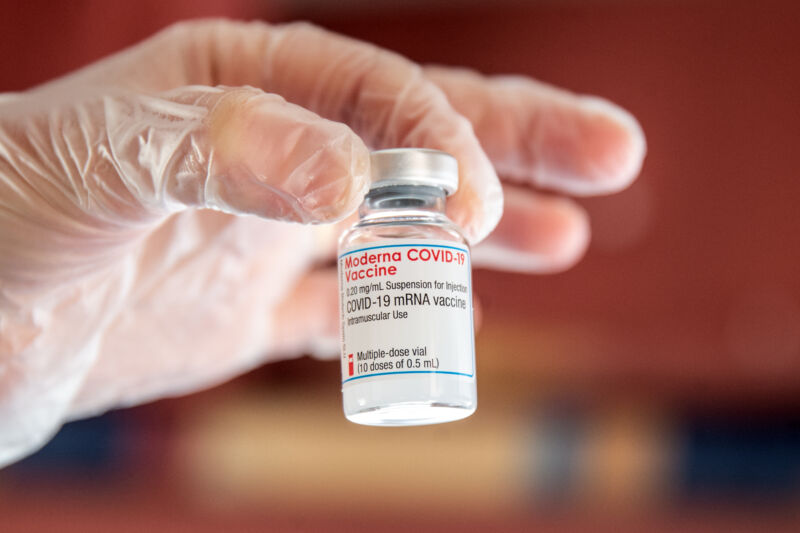
A combined COVID-19 booster dose targeting the ancestral strain of SARS-CoV-2 and the original omicron variant, BA.1, appears to outperform the current booster against both versions of the virus, Moderna reported Wednesday.
Moderna specifically says that the combination booster increased neutralizing antibodies to omicron 8-fold, while the original booster increased antibody levels only about 4.4-fold.
The vaccine maker is aiming to make this bivalent injection — dubbed mRNA-1273,214 — the go-to booster for seasonal shots this fall. The company will submit its data to the Food and Drug Administration in the coming weeks and hopes to have the bivalent booster available by the end of summer, if not early fall.
Moderna says this dose is the second bivalent design to surpass its current booster. In April, the company reported data that a bivalent booster targeting the ancestral strain and beta variant (booster mRNA-1273,211) could also outperform the current booster. That data solidified the company’s trail to focus on bivalent boosters in the future.
“We are pleased to share the preliminary data analysis of mRNA-1273,214,” Stéphane Bancel, CEO of Moderna, said in a statement on Wednesday. “Looking at this data in addition to the durability we saw with our first bivalent booster candidate, mRNA-1273,211, we expect more durable protection against variants of concern with mRNA-1273,214, making it our lead booster candidate in the fall of 2022.”
Increased uncertainty
There is still a lot of uncertainty about a fall booster campaign, including which boosters will be offered and to whom. It is also still unclear whether SARS-CoV-2 will become a seasonal virus. But given the ongoing waves of variants and subvariants, along with dwindling immunity from current vaccines and boosters, vaccine makers, regulators and experts have broadly accepted the idea of a fall booster campaign for this year.
The FDA will convene its panel of independent expert advisors on June 28 to plan for fall and future boosters. In particular, advisors will discuss “whether and how to adjust the composition of the SARS-CoV-2 strain of COVID-19 vaccines.” The panel – the Vaccines and Related Biological Products Advisory Committee (VRBPAC) – will not focus on specific products, but will help develop guidelines for updating COVID-19 vaccines, as well as guidelines for determining formulas for annual flu shots. Moderna said it would present some of its data at the meeting.
The meeting is already starting to be a particularly challenging one. If vaccine makers want boost doses made, distributed and ready to go into the fall, they need to have the design selected and production to start as soon as possible. But the data driving the design decisions will be extremely limited. For example, Moderna’s latest bivalent booster is based on the BA.1 omicron sub-variant, which is no longer circulating in the US. In fact, two sub-variants – BA.2 and BA.2.12.1 – have already achieved dominance since the BA.1 wave in January. And two additional sub-variants – BA.4 and BA.5 – seem poised to catch up with the current prevailing version of omicron, BA.2.12.1.
Varying variants
Preliminary data suggest that the newer subvariants may evade antibody responses generated by BA.1 infection, raising concerns that a BA.1-based vaccine design may be less effective on current subvariants.
Moderna presented no data on how well its BA.1-targeted bivalent vaccine performs against newer omicron subvariants. But it’s not even clear that such data would be relevant for the fall, given how quickly subvariant waves have come this year. By winter yet to be identified variants or sub-variants could be circulating.
In a webcast Wednesday, Moderna president Stephen Hoge addressed this shortcoming, essentially saying that the levels of antibodies they see with the new ommicron-based bivalent booster are high enough that even if efficacy is reduced by new sub-variants, the booster will still always protective.
“We are confident that the data we have shows it is appropriate” to update the booster with this bivalent design, Hoge said. “In fact, we think that [it’s] It is highly desirable to update the vaccine sequence with an omicron containing variant due to its ability to achieve significantly higher titers, which we believe will correlate with better durability and better protection against omicron subvariants over winter. .”
So far, Moderna has no data to back that up. But the data it has looks strong so far, at least to protect against BA.1 and defeat the original booster.

